AUDUBON REPORT

Collaborations Lead to Conservation
Terry
Robert
Suzanne
Steven
Frank
Julia



Collaborations Lead to Conservation
Terry
Robert
Suzanne
Steven
Frank
Julia


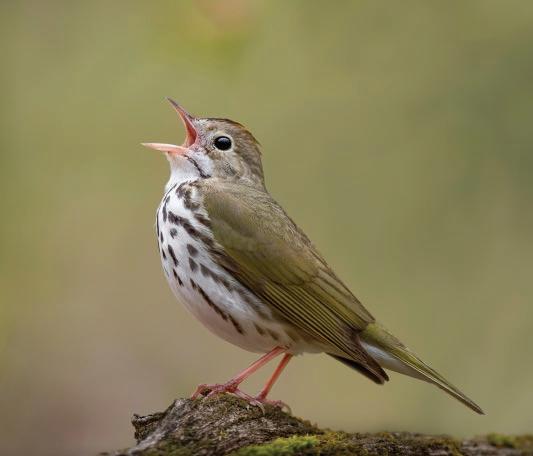
Audubon Society of Rhode Island 12 Sanderson Road, Smithfield, RI 02917 401-949-5454 www.asri.org
Executive Director: Jeffrey C. Hall
Managing Editor: Hope M. Foley
Contributing Writers: Laura Carberry, Hope Foley, Abbie Lahmers, Lauren Parmelee, Scott Ruhren, Katie Schortmann
Contributing Photographers: Peter Green, Butch Lombardi, Jason Major, Glenn Osmundson, Scott Ruhren, Richard Staples, Jessica Weinberg
The Report is Audubon Society of Rhode Island’s newsletter, updating members and supporters on current news, policy issues, research and initiatives being led by the organization, staff, and volunteers.
We encourage your participation. Please send items that will be considered for publication to Managing Editor Hope M. Foley at hfoley@asri.org.
Please pass this copy on to a friend or recycle. Thank you.
Recently, I visited a nature refuge on Long Island, a beautiful peninsula that extends out between Noyack and Little Peconic Bays. Protected by the U.S. Fish and Wildlife through a donation from Elizabeth Morton in 1954, it is an invaluable spot for migratory birds, with an accessible trail and lookout.
What struck me most though, was that you had to pay to enter this protected area. As I fumbled for change to pay the fee, I reflected on the work Audubon has been doing this year to remove barriers like these, so that all people can access the natural world.
Audubon has long worked to protect wildlife habitats and teach environmental literacy. But in 2025, we have also looked inward — examining how we can remove barriers, welcome new voices, increase accessibility, and strengthen the bonds between people and nature.
We have been working with, and listening to, communities and partners across Rhode Island to expand our programs and initiatives to meet people where they live. Our education team has been at the forefront of this transformation. From Providence and Pawtucket to Central Falls, Audubon educators April Alix and Lisa Maloney are bringing live raptors to city recreation centers, hands-on science to classrooms and green spaces, and providing nature-based experiences in communities that have historically been underrepresented in outdoor spaces.
The goal is always to inspire curiosity about the natural world and help students and families discover that nature is not somewhere far away, but right outside their doors.
Accessibility is another cornerstone of this work. Partnering with organizations like RAMP (Real Access Motivates Progress), we are taking meaningful steps to ensure that all visitors —regardless of mobility, language, sensory or other needs — can experience the wonder of the Audubon Nature Center and Aquarium. Whether it’s accessible picnic tables, trail improvements, or adding braille and Spanish translations to signage, our goal is simple: we believe access to nature is a right, not a privilege.
And while we work to connect people to nature, we also continue to safeguard the lands and waters that make Rhode Island unique. In recent weeks, the donation of a 55-acre conservation easement by Anni and Vahe Bedian expanded the protection of the Maxwell Mays Wildlife Refuge—a testament to the power of partnership and our donor’s conservation values. This land, rich in forest, vernal pools, and wildlife, will remain untouched for generations to come.

Our scientists are also confronting the realities of a changing climate. Senior Director of Conservation Scott Ruhren’s work on drought-stressed habitats underscores the urgency of land protection as we work to build climate resilience. Every acre conserved provides shelter for wildlife, absorbs floodwaters, and helps buffer our communities against extreme weather.
You, our volunteers, members, and partners who give their time and talent so generously, ARE the lifeblood of Audubon. From Osprey monitoring and maintaining trails, to working in the pollinator garden, educating visitors, and collecting data on our wildlife refuges, volunteers are critical to our work. Your service “ripples” outward, inspiring others to join us and ensuring that Audubon’s impact continues to grow.
Leadership in the RePower Audubon initiative—our bold plan to make our organization fully net-zero by 2030—has reached a major milestone, thanks to generous donors. We have formally signed an agreement to install a solar array carport canopy over the Nature Center and Aquarium’s parking lot, which will power the entire Nature Center campus with 100% renewable power! This brings us one step closer to a clean energy future.
As I look ahead, I see an Audubon that is vibrant, inclusive, and forward-thinking, an organization grounded in science and advocacy, powered by community, and sustained by a shared belief that nature belongs to everyone. Thank you for your partnership. It fuels our mission, keeps the trails open, the classrooms alive with curiosity, and the skies above filled with the wings of possibility.
AUDUBON IS TRULY POWERED BY YOU!
Good birding,
Jeffrey C. Hall Executive Director

Audubon Associate Director of Education April Alix brought nature programming and avian ambassadors to Providence community centers last summer. Shown here, she presents a Red-tailed Hawk to children at the John H. Rollins Recreation Center.
Story by Abbie Lahmers • Photography by Richard Staples
At the Sackett Recreation Center in Providence, kids file into the gymnasium one summer morning eager to see an owl. An owl in a gymnasium isn’t a regular occurrence, and the children have likely never seen one before, nor do many realize that a few species of these amazing birds live among them, right in their own city. Birds flock in the peripheries of our daily lives, even in urban settings, which is perhaps why they can be such an effective conversation starter when it comes to placing ourselves – no matter who we are or how old – in the bigger conservation picture.
April Alix, Audubon Associate Director of Education, primes her audience of curious young naturalists for the encounter and lets them interact with biofacts, such as wings and skulls, if they choose to. Sometimes it’s these safe, comfortable first encounters that can make all the difference for children, and families, to connect with the natural world we all belong to.
One of Alix’s favorite quotes, by naturalist and author Robert Michael Pyle, posits, “What is the extinction of a condor to a child who has never known a wren?”
This question informs Alix’s mission of translating “aha” moments and wildlife encounters into advocacy and belonging. “Cities are very underrepresented when we talk about
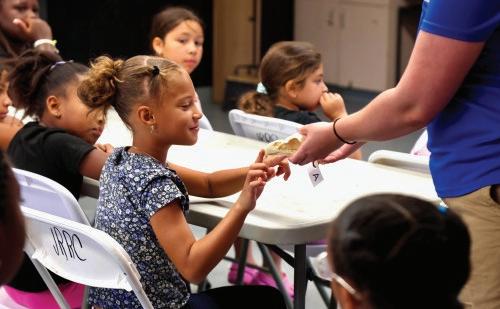
wildlife and the importance of green spaces, but cities hold a very important role especially for migratory species that use these areas as stopover points,” notes Alix. “It's important for kids that are living in cities to recognize their role as stewards and to show them that we have super cool animals living close by.” The goal is to have small epiphanies turn into actions – simple things like not littering because trash in the street invites raptors into harm’s way or keeping cats inside to protect birds, and later in their lives, becoming aware of their water usage or considering eco-conscious choices like electric cars and installing solar panels.
Audubon has long worked with schools, libraries, and community centers…now we are reaching beyond our traditional partners and meeting a more diverse audience of people where they live, providing positive experiences in the green spaces in their communities, and addressing environmental issues that directly concern them.
– Lauren Parmelee, Audubon Senior Director of Education
Both Alix and Audubon Community Education Coordinator Lisa Maloney emphasize the importance of sparking curiosity in the programming they design. Maloney works with numerous school districts, community centers, and other institutions to find out how best to bring environmental education to learners. She has led one of Audubon’s longest partnerships with the Pawtucket schools for 20 years, bringing free in-school programs to every third grader in the city school district, with an accompanying spring field trip to the Audubon Nature Center and Aquarium. This provides students the opportunity to engage with Audubon through hands-on environmental curriculum twice during the year.
“Audubon has long worked with schools, libraries, and community centers, and provided high-quality summer camp programming for families,” says Audubon Senior Director of Education Lauren Parmelee. “Now we are reaching beyond our traditional partners and meeting a more diverse audience of people where they live, providing positive experiences in the green spaces in their communities, and addressing environmental issues that directly concern them.”
Part of Audubon’s educational messaging is that people are not separate from nature, but rather a significant part of it. The choices we all make can have significant impact — positive or negative. “As human-caused climate change impacts our neighborhoods, it is important to share what action steps a group of people can take to mitigate the effects,” says Parmelee. “The work that Audubon does with the Stormwater Innovation Center and the Youth Conservation League plays an important role in helping to spread these messages.”

Audubon’s expanding mission of “connecting ALL people with nature” also includes a focus of making nature more accessible to everyone. “It is an ongoing priority for Audubon to become more inclusive and accessible,” says Audubon Executive Director Jeff Hall.

Community Education Coordinator
“We know that there are challenges that people face to get outside and experience the benefits of nature. We want to be part of the solution.”
In an effort to minimize physical and mobility barriers, Audubon recently invited Tina Guenette of RAMP (Real Access Motivates Progress) – a Rhode Island nonprofit committed to creating more equitable spaces – to do a roll-through of the Nature Center and Aquarium’s indoor and outdoor areas in Bristol, to assess accessibility infrastructure.
This process revealed some barriers with simple fixes – like the way the doors swing in bathroom stalls – as well as some more substantial projects, like addressing the slope of the meadow trail, which presents challenges to those in manual wheelchairs. Audubon has already installed accessible picnic tables and hopes to also add a Tina Table (developed by RAMP and constructed by the Steel Yard in Providence) to provide a range of sitting options for different sensory and mobility needs. Including braille and Spanish translations on signage would mean more people can understand and interpret the wealth of information Audubon provides.
These concrete goals position the Nature Center and Aquarium as a more accessible gateway to the organization, inspiring curiosity and connecting visitors to the wonders of the natural world. Immersive experiences are an important part of this plan, as are removing barriers to accessibility and being fully inclusionary in their work. “We don't believe access to nature is a privilege,” says Hall. “Audubon believes it is a right for all people.”


“Developing relationships in new aspects of a community or with new audiences requires the time, attention, and the ability to really listen to what people are saying they need and want,” says Parmelee. “Audubon educators and staff are committing that time and attention to students, adults, families, and teachers in Rhode Island communities.”
Continued on page 8.
Continued from page 7.
The partnerships and education outreach detailed below are just a few of the ways that Audubon educators are working with new audiences and engaging people in the communities where they live.
April Alix has only been in her role as Audubon Associate Director of Education for less than a year, but her environmental education experience goes way back, beginning with an AmeriCorp placement with Audubon in 2010. Later, as the conservation program coordinator of the Providence Urban Wildlife Conservation Partnership, she worked at many city recreation and community centers and with schoolteachers in the community.
In her full-circle return to Audubon, she brings a piece of wisdom: “One of the things that I stand by with my heart and soul is that you cannot just walk into a space and do programming,” says Alix. “What I learned from my work in Providence is that I shouldn't determine for a community what they need. My first step is always to listen to partners, residents, and members to learn what their priorities are, and how we can support and provide value to their communities.”
This summer, April Alix hosted two raptor programs for kids at Providence Recreation Centers, collaborating with the Providence Urban Wildlife Conservation Partnership and Partnership for Providence Parks, to bring everyone outside for a birding activity after the presentation. Alix ensured these presentations were engaging at every turn, answering every curiosity-fueled question and inviting kids to spread their wings – or rather the literal biofact wings of raptors – to see the different advantages of owl and hawk feathers. Even in the short amount of time, she had everyone (even the rec center staff) noticing – the owl’s talons, the set of their eyes, the shape of the beak – and making inferences from those observations.


“It doesn't matter if you live in a rural, urban, or suburban area – we want to build empathy,” says Alix, and these introductions to wildlife in safe, encouraging spaces lays that foundation.
“
My first step is always to listen to partners, residents, and members to learn what their priorities are, and how we can support and provide value to their communities.
–April Alix, Audubon Associate Director of Education
“
The global education network, Big Picture Learning, celebrated their 30th anniversary of opening the Met School in Providence this summer, and hosted a week-long national conference in Rhode Island. This network of over 275 schools believes that learning can happen outside of the school as much as within it.
Audubon was invited to run an off-site field trip for their visiting educators, centered around community building and outdoor activities. Lisa Maloney developed a teacher workshop – which naturally included a bird-themed icebreaker – and shared ways that teachers could use fun, approachable activities with their students as avenues into bigger discussions of climate change and environmental justice. “The goal was to model the kind of environmental lessons that they could do with high school or middle school students in the communities where they live,” explained Maloney.
Cohorts of high school and college students have been stepping into stewardship roles through the Youth Conservation League (YCL) for more than 10 years, a program managed by Audubon. Traveling to Audubon wildlife refuges, as well as other parks and conservancies, these young conservationists learn from experts and get their hands dirty on a range of projects. The mission of this paid summer program is dualpronged, giving young people meaningful summer employment and the practical skills and connections needed to explore their future career prospects in a competitive field, while also completing important conservation-oriented tasks that improve these spaces for visitors and wild inhabitants alike.
This summer, the YCL crew worked for two days in Neutaconkanut Park in Providence, a new connection that Associate Director of Education April Alix helped facilitate. They trimmed trails and even contributed to constructing a new one. Says Properties Director Laura Carberry, “The group has become aware of what it takes to make the trail safe and comfortable for hikers to walk. They tackled invasives and helped create an environment that is more suitable to pollinators and other native animals.”
“For many students, parks like Neutaconkanut are their introduction to the natural world,” Carberry notes. “They can get up close to insects, hike, and see native wildlife right where they live.” One crew also worked with the Woonasquatucket River Watershed Council weeding pollinator gardens, and another group planted native species in Scituate.
“Working in Providence, Central Falls, and Pawtucket is huge for these students,” says Carberry. “It plants the idea that it is possible to create safe outdoor places in all communities. It also helps residents foster a sense of stewardship for those native habitats.”


The Taking Root Initiative has allowed us to expand what we offer. Nature isn’t just for someone who is nondisabled. Nature is for everybody.
– Lisa Maloney, Audubon Community Education Coordinator

Working in Providence, Central Falls, and Pawtucket is huge for these students. It plants the idea that it is possible to create safe outdoor places in all communities. It also helps residents foster a sense of stewardship for those native habitats.
– Laura Carberry, Audubon Director of Properties
Through the Taking Root Initiative, Audubon educators have developed indoor and outdoor nature-based curriculum tailored to learners requiring a range of accommodations, by working with teachers at schools and centers that serve students with special needs.
Sometimes this takes the form of creating a quieter environment for programming or giving lots of choices for how participants experience the material. Mobility issues are always taken into consideration, and if a field trip to the Nature Center and Aquarium isn’t feasible, educators bring the lesson to their school. Each decision is informed by an initial conversation: “Tell us what your students need to succeed.” Says Maloney, “We really want to think about that so we can be intentional in our program planning, but also flexible.”
Because even with the best laid plans, a bus breaking down or unpredictable weather can upend expectations, requiring educators to thoughtfully pivot. Just recently, when a series of unavoidable transportation mishaps brought a busload of students to the Center almost an hour late, Maloney knew the students might be feeling emotionally dysregulated when they arrived. The staff was ready to adapt the lesson, shortening the intro to ensure there was enough time for the activity and minimize disruptions in the schedule.
It’s these kinds of situations that make it all the more important to preview participants ahead of time. Mount Pleasant Academy recently requested what are known as “social stories” before their visit to the Nature Center and Aquarium – detailed descriptions and photos of what the space looks like, what students will encounter (such as the huge model of a right whale in the aquarium entrance), the people they’ll meet, a schedule of events (including when lunch will take place!), and some of the sensory experiences. All of this information helps ease the transition of visiting a new place.
“The Taking Root Initiative has allowed us to expand what we offer,” notes Maloney. “Nature isn't just for someone who is non-disabled. Nature is for everybody.”
Continued on page 38.
By Dr. Scott Ruhren, Senior Director
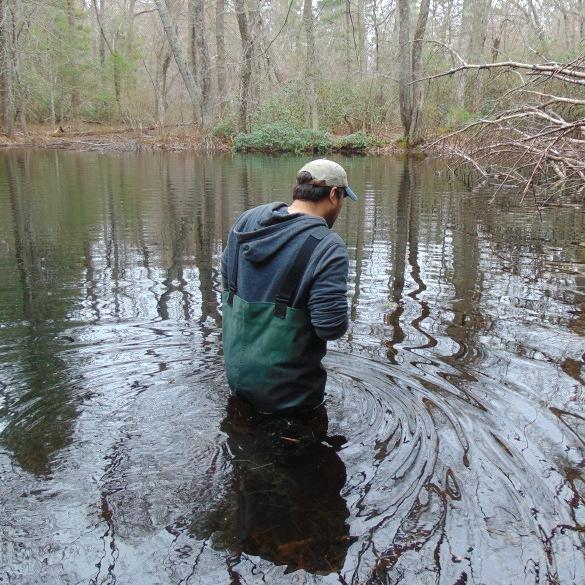

Audubon’s habitat protection increases the chance of survival for species stressed by limited water resources.
In August, the bottom of a large vernal pool at Fisherville Brook Wildlife Refuge in Exeter was almost completely exposed, only a sliver of water remained. It was concerning – and unusual – to see this large pool almost dry. Fortunately, the frogs and salamanders had completed their development early enough and emerged
successfully. While in a smaller pool at the Maxwell Mays Wildlife Refuge in Coventry, shriveled remains of wood frog egg masses lay dry and lifeless in May due to lack of sufficient water. They were not so lucky. This small and shallow vernal pool was unable to survive the extensive drought in Rhode Island.


Droughts have become more common in New England and can last several years. While scientists are trying to predict what this means for the future, Rhode Islanders are seeing the impacts and challenges in dry wells and reduced flow in streams and rivers. Historically, humans have perceived drought from agricultural and cultural perspectives. People notice brown lawns, parched gardens and reduced apple crops, but the effects on wildlife and their habitats may go unnoticed.
Drought reduces water and food available for birds and other wildlife. Stressed plants produce less seeds and fruits, crucial summer sustenance and fall foods for hungry migrating birds. Many water-dependent species disappear. Fungi were noticeably absent from the landscape on many wildlife refuges until late summer rainfall.
Lack of rain typically makes coastal habitats saltier because the normal freshwater flowing to the sea is gone. More salt is an additional stress for even highly adapted species in salt marshes and estuaries.
As weather patterns change and become more extreme, many of Audubon’s properties protect the quality and quantity of water resources by storing water in wetlands and reducing stormwater runoff. – Scott Ruhren “ “
Thankfully, many species are resilient. Some plants have adapted to dry summer conditions by going dormant and resurrecting when conditions improve. Aboveground stems may die but if the roots can survive, they will sprout new growth next year. Clumps of spice bush on the edges of wetlands at Powder Mill Ledges in Smithfield show stems killed by drought, but they should be back in spring.
Vulnerable plants and animals, not as adaptable, may die or be forced to change location or behavior in response to drought. Dry habitats are also more prone to fire and the various aftereffects, and recovery is slowed by lack of rain.
At Audubon’s Davis Memorial Wildlife Refuge in North Kingstown and East Greenwich, this year’s extended hot and dry spring and summer weather made it difficult to restore habitat recovering from recent powerline construction. Beavers in the Hunt River within the Davis property increased their dam building in response to drought, flooding upstream habitat.
Conservation land is crucial for climate resilience. As weather patterns change and become more extreme, many of Audubon’s properties protect the quality and quantity of water resources by storing water in wetlands and reducing stormwater runoff. Audubon’s habitat protection increases the chance of survival for species stressed by limited resources.
Rhode Islanders have traditionally had plenty of fresh water available. Still, whether you are on town water or a well, water conservation at home can indirectly help wildlife. Regardless of the drought status in the state, we can all work together to support land conservation and conserve this valuable resource.
Visit asri.org/wishlist for the complete list and to donate. Donate Today and Support Audubon!
• Sponsor Monthly Free Family Fun Day
Provide free admission to the Nature Center and Aquarium. $1,000/day
• Trail Cams
Help Audubon monitor parking lots and gather data on visitation. $150/camera
• Litter Pickup Gear
Gloves, poison ivy wipes, grabbers, and trash bags are needed. $600
• Fund Crafts for Kids
Fund a year of supplies and materials for children’s crafts at the Nature Center and Aquarium. $3,000
• New Septic System for Caratunk Wildlife Refuge
Donate and support one of Audubon’s most popular refuges. $35,000
• Lumber for Bog Bridges
Fund much needed bridge replacements and repairs. $5,000
• Sponsor One Bus…or More!
Transport a school group to an outdoor field trip. $400/bus
• Nature’s Calling
Cover the cost to keep the portalets on the wildlife refuges clean for a full year. $6,000/year

Thank you for your support!
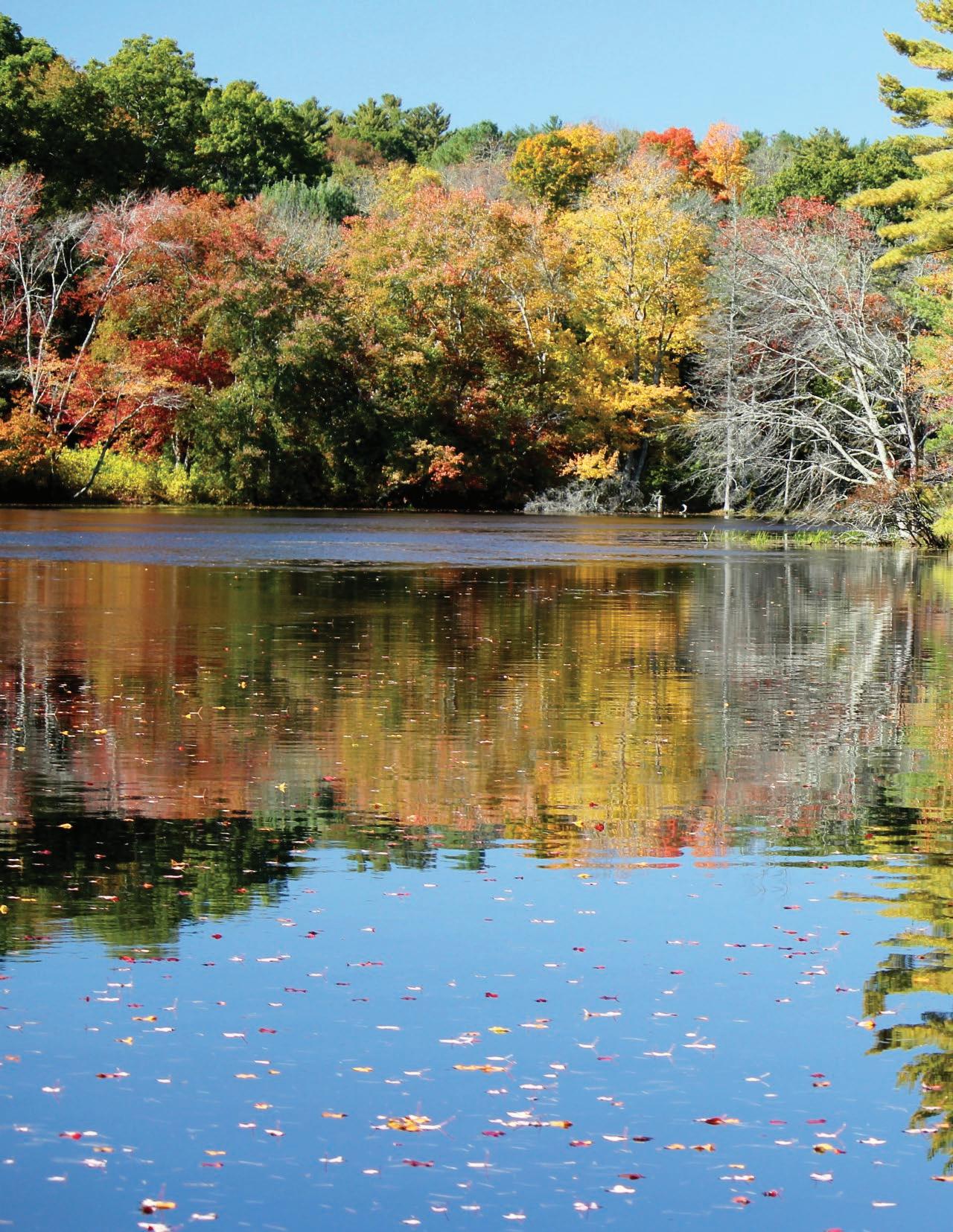
They have gotten their hands dirty in the Palmieri Pollinator Garden, expanding a haven for wildlife. Others have monitored Osprey for years to capture data on the nesting success of these summer visitors. Some bring experience with carpentry to build boardwalks. There is a team that engages with the public in the Nature Center and Aquarium, at events like Raptor Weekend, and on the trails. And still others participate in community science initiatives in Roger Williams Park or on our wildlife refuges.
Audubon’s volunteers are more than names on a spreadsheet; they are a community providing essential time, talent, and support for nature. And as Audubon continues to expand its science initiatives, programming, and land acquisitions, our committed pool of volunteers is more critical than ever.
These individuals have given Audubon much more than volunteer hours; they have provided a ripple effect in Rhode Island communities. Not only do volunteers often recruit friends, but many interact with the public, encouraging new members and supporters as they share their experiences and passion for Audubon’s work.
From Cumberland to Westerly and the East Bay to Coventry, the following pages tell the stories of Audubon volunteers from across the state and why they relish their role in supporting the nature of Rhode Island. Audubon thanks these and all of our volunteers for their commitment. Like Audubon staff, these volunteers are a welcoming bunch. Please consider joining them and support Audubon in your community.


“I volunteer at Audubon as a way of giving back to the greater community and to support the efforts and goals of the Audubon Society of Rhode Island. I personally have benefited over many years from being outdoors in various refuges, hiking with my children, with friends or by myself. It’s a wonderful way to decompress and reflect on the wonders of the natural world. Now that I am retired, I have the time to reinvest my efforts and meet like-minded people as I support Audubon.”
Above: Bob Sand with his daughter Mirah, who first hiked an Audubon wildlife refuge strapped in a toddler carrier on Bob’s back over 30 years ago. “A lot has changed in 30 years, but not our love of nature.”

“After relocating from my hometown, Hong Kong, to Rhode Island for my husband’s job, I sought to learn something new and contribute meaningfully. Since I love nature and hoped to connect with the local community, I joined Audubon as an Exhibit Hall Guide in 2018.
Working as a graphic designer in Hong Kong allowed me to share my skills through a few collaborative projects with staff, including designing graphic backdrops for an entrance display cabinet that helped explain and echo the items showcased inside.
Over time, I’ve deepened my appreciation for nature through coworkers’ guidance and personal exploration. I enjoy seeing visitors have fun—especially children during scavenger hunts, where even the smallest smiles and interactions bring me joy.”



“After completing the URI Master Gardener program in 2023, I was so happy to have the opportunity to become a volunteer at the beautiful Palmieri Pollinator Garden. I've learned so much about native plants and our pollinators from Katie Shortmann's (Audubon Pollinator Outreach Coordinator) knowledge, expertise and guidance. She creates such a welcoming environment for volunteers and visitors alike and it is an honor to contribute to maintaining such a lovely natural space for all to enjoy and learn from. Spending time in the garden is always a highlight of my week!”
“I am a trail monitor for the Davis Memorial Wildlife Refuge in North Kingstown and have helped with trail/refuge maintenance in the winter for roughly two years.
I chose to volunteer with Audubon as I am a bird enthusiast who believes in the importance of preserving natural environments for all native flora and fauna to survive. While a busy life in underground construction keeps me from helping out as much as I would like, I’m very proud to play a small role in preserving nature at Davis Memorial and working at other refuges with Mike Cavaliere and other Audubon conservation staff. My favorite times volunteering have been helping to remove damaged boardwalks, downed trees, and general maintenance around all the wildlife refuges. Everyone I have worked with is so knowledgeable about the history of the land, it’s fascinating to learn about each property while working at them.”
“ “
I chose to volunteer with Audubon as I am a bird enthusiast who believes in the importance of preserving natural environments for all native flora and fauna to survive. – Ryan Lowry
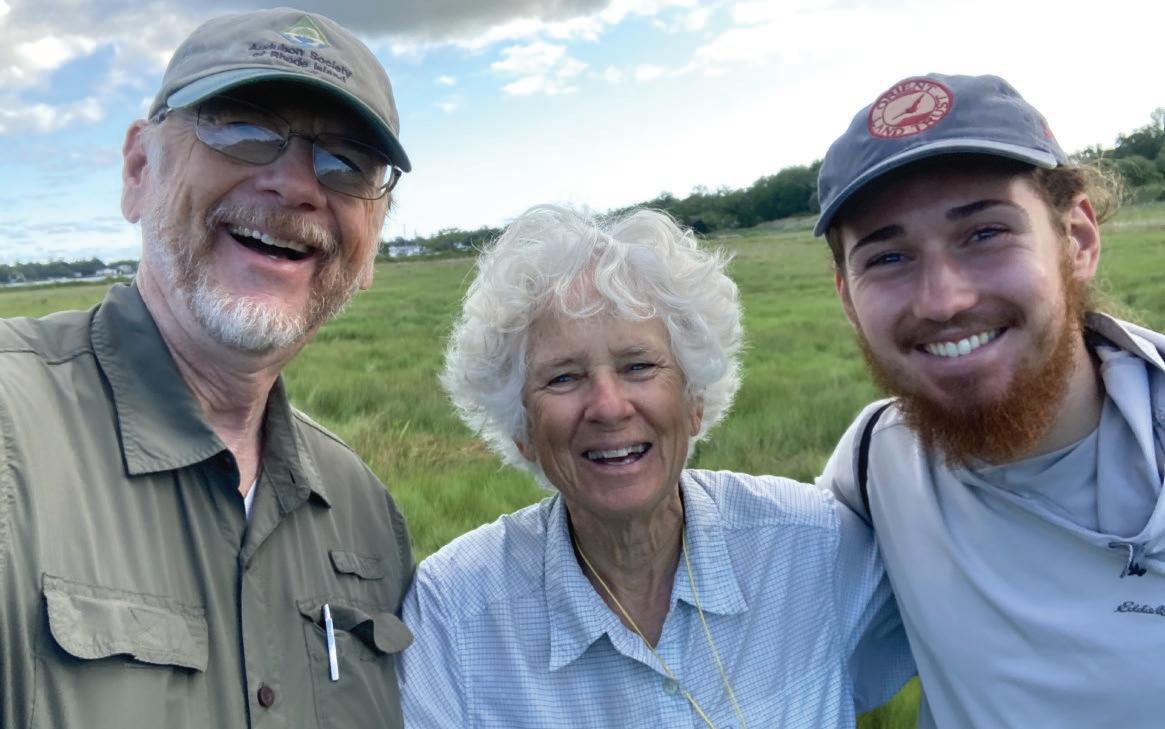
Bristol, RI Y EARVOLUNTEER
Avian Research Initiative Bird and Insect Surveys, Bird Banding Volunteer, and Osprey Nest Monitor
“Volunteering with Audubon and attending their programs was one of the ways I made new connections following my retirement and subsequent move to Bristol, RI. One of my goals was to spend more time in nature and find ways to contribute to conservation. Audubon programs have been a big part of this.

Through my association with the Saltmarsh Sparrow Research Initiative, I became involved in bird banding and volunteered to help with Audubon programs in Bristol and Seekonk. I also participated in several of the Avian Research bird surveys in 2022 that led to the establishment of Audubon "responsibility birds" and I also participated in insect surveys. My longest association with Audubon has been through the Osprey Nest Monitoring Project, volunteering from 2017 through the current season.
Working as an Audubon volunteer has provided me with opportunities to learn about our natural environment and gain new skills. It has also given me a sense of accomplishment by helping young people to develop their understanding of the natural world.”
Bristol, RI Y EARVOLUNTEER
Community Science Volunteer
“Volunteering to monitor vernal pools at Fisherville Brook (2024) and Caratunk Wildlife Refuges (2025) has been a highlight of the early spring seasons. What better way to welcome the end of winter than to watch the ice melt off these temporary ponds and watch for herps to emerge and deposit egg masses?
I just can’t say enough about how well Ethan Paiva (Audubon Land Steward) orchestrated this program, making it available — and enjoyable — to a wide variety of volunteers. He supplemented great information on the species that we were likely to see with helpful instructions and encouragement.”
– Deirdre Robinson “ “
I just cannot say enough about how well Ethan Paiva [Audubon Land Steward] orchestrated this program, making it available — and enjoyable — to a wide variety of volunteers.

Warwick, South Kingstown, RI
Osprey Nest Monitor
“When I retired, I took advantage of the wonderful Wednesday birding walks offered through Audubon. When I heard of the Osprey nest monitoring program, I found the perfect opportunity to become more involved. The longer I monitor, the more I notice about the Osprey and other birds; it has sharpened my eyes and awareness. Monitoring has also given me the opportunity to share my interest with people who pass by - usually assuming I am taking photographs and asking if I have had any luck. Offering a view through the scope trained on a nest is standard.
Lincoln Dark, who leads the program, is a terrific resource, asset, and supporter. His knowledge, skill set, and enthusiasm have taken the Osprey Monitoring program to new levels of community involvement. I am grateful for the opportunity to be part of this effort and thank the Audubon Society of Rhode Island for its energetic efforts on behalf of nature and wildlife in this beautiful state.”

Osprey Nest Monitor and Community Science Volunteer
“Growing up in a family in which nature, the out-of-doors, and a love of our National Parks were part of our daily lives, I am drawn to any activity that deepens my knowledge and appreciation of nature, particularly birds. The opportunity to develop a better understanding of the Osprey was too good to pass up! This experience has given me invaluable understanding of this magnificent bird and its importance to the balance of nature in our part of the world.”
Above:Mary Di Cecco observing a successful nest on her observation list this summer; Niantic Avenue, Westerly, RI.
This experience has given me invaluable understanding of this magnificent bird [Osprey] and its importance to the balance “



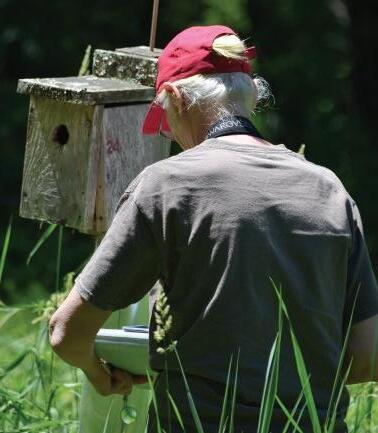
“Volunteering for Audubon over the past four years has been rewarding and has become a lifestyle. Working with a team of two, I have enjoyed the quiet solitude, photography, process and proceeding as a citizen scientist to furthering my knowledge to help the Eastern Bluebird. I also remember Mrs. Hawkes* as a third grade teacher and have fond memories of her instilling her students with an early appreciation for nature. I hope to be back next year.” – Bonnie Reismann
“Al and Marie Hawkes* were very good friends. It is a pleasure to be a part of an Audubon program and give back to remember all their generosity and work that helped Audubon become the great organization that it is today. I enjoy every time I go out in the field.” – Diana Reismann
*The late Al Hawkes was Audubon Executive Director from 1958 to 1993. Together, he and his wife Marie were an influential team when it came to advocating for environmental education and policy.


Providence, RI
VOLUNTEER
“I’ve always loved birds, so I jumped at the chance to support my friend Jessy Minker* through the community science project that she was coordinating for Audubon. Through training, I learned that the fecal matter of geese contributes to algae blooms and affects water quality.
Each month, I would trek around the familiar route of bodies of water at Roger Williams Park, tasked with counting the Canada Geese. I would delight in each goose sighting, watching goslings grow each month. How lucky I felt discovering that the data from observing my waterfowl friends would contribute towards better understanding of local water pollution. Thanks, Audubon!”
*Jessy Minker is a former Audubon TerraCorps Service Member and current per diem educator.
Jeanelle Wheeler observing Canada Geese in Roger Williams Park.

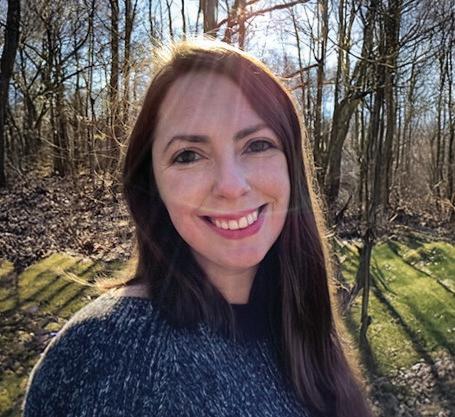
Burns
Coventry, RI Y EARVOLUNTEER 3
“I started volunteering with Audubon because nature makes me happy - and litter makes me mad. I love trees, frogs, hiking, even bugs (some bugs). But nothing cramps a trail’s style like a Dunkin cup tossed like it’s no big deal. So, I pick it up, get my steps in, spot deer and owls, try to memorize different bird songs, and imagine what it was like way back in the day when I look at historic remnants scattered around.
It’s peaceful and purposeful. Knowing that my company also donates $1,000 for every 100 hours I’m out there makes me feel like I’m making a difference. Maybe someone reading this works somewhere with a similar benefit – check it out because it’s super fun!”
Above: Katie Burns on the trails at Parker Woodland Wildlife Refuge in Coventry.

Steven Levine
Narragansett, RI Y EARVOLUNTEER 3
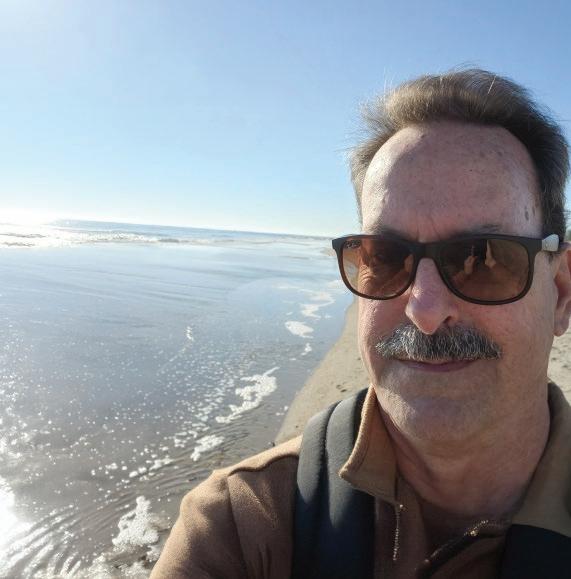
Coventry, RI Y EARVOLUNTEER 1
Crew Days Volunteer
“I have been an Audubon member for quite some time and live near several trails, which I frequently take advantage of. Now that I am retired, I have lots of free time and thought of volunteering as a way to give back.
I have been volunteering mostly at Maxwell Mays but have also helped out at Fisherville Brook and Parker Woodland Wildlife Refuges. This has mostly been through the monthly Crew Days, although at Maxwell Mays, we usually go every two weeks! I also helped with the boardwalk installation at Caratunk Wildlife Refuge in Seekonk last fall.”
Above: Mark Synowiec enjoying nature at Napatree Point.
“After retiring, I volunteered for MassAudubon in the Worcester, MA area. When I moved to Rhode Island a little over three years ago, I wanted to continue “working” outdoors. Audubon Society of Rhode Island provided that opportunity.
After working indoors all my career, I began to appreciate the beauty and value of being outside. It is important that we all do our part to keep open spaces available to everyone. What I find most amazing at Fisherville is the respect those on the trails have for nature and the environment. I rarely find evidence of human activity. Maintaining the trails ensures that the wildlife refuge is safe and enjoyable for hikers and families who are out for a peaceful walk surrounded by the natural beauty of trees, ponds, and wildlife.”
Fisherville Brook Wildlife Refuge Trail Monitor Steven Levine.
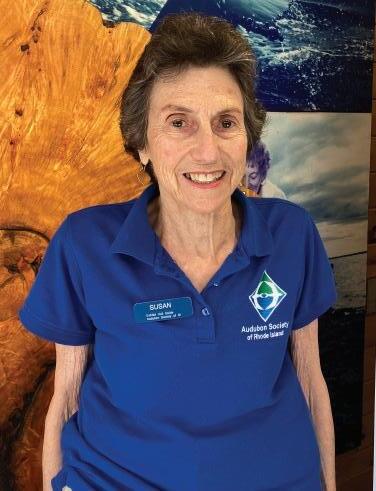
Providence, RI Y EARVOLUNTEER
Nature Center and Aquarium
Exhibit Hall Guide
“I have always been an outdoor person and after I retired from a career in mental health, I sought a place to volunteer. I found my perfect fit at Audubon. Not only have I enjoyed the staff at Bristol, the other volunteers, and the many visitors I have met, I have also learned so much about nature and protecting the environment. Volunteering for Audubon has enriched me and made me feel optimistic that there is widespread interest and support for the environment and our precious natural resources.”
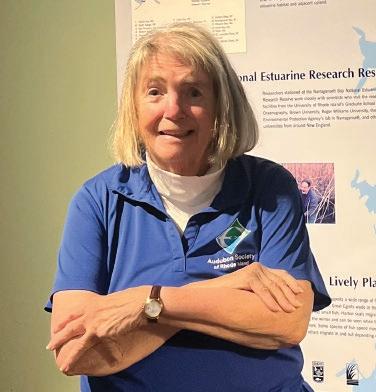
Nature Center and Aquarium
Exhibit Hall Guide
“As a seven-year volunteer at the Guana Tolomato Matanzas National Estuarine Research Reserve, in Northern Florida (one of 30 NOAA and state partnerships), I found Audubon’s mission and exhibit hall to have similarities (including both facilities having large models of right whales.)
I enjoy conveying how the Audubon exhibits reflect the habitats found on the grounds of the Nature Center as well as the Narragansett Bay ecosystems. I also learn from knowledgeable visitors, often children, who proudly declare ‘I watch (PBS) Wild Kratts.’ However, I’m most impressed by Audubon’s private funding, comprehensive publications, and community projects. I am proud to be a member.”
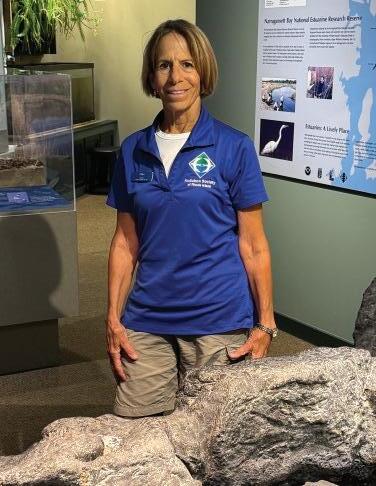
Cumberland, RI Y EARVOLUNTEER 6
Nature Center and Aquarium
Exhibit Hall Guide, Events Volunteer, Beach Cleanup Captain
“I was drawn to the Nature Center and Aquarium after I retired from teaching middle school science. I am a marine scientist and had worked for Audubon before on a marine science curriculum. At the Nature Center I can discuss my favorite topics with guests of all ages – with the 3-year-old curious about an animal, or with the fisherman discussing whale conservation. It’s a worthwhile way to use my background and my time.”

Volunteering for Audubon has enriched me and made me feel optimistic that there is widespread interest and support for the environment and our precious natural resources. – Susan Beck “ “

Providence, RI
“As a frequent walker in Roger Williams Park, I was intrigued by the efforts being made to improve the quality of water in the lakes, often listed as having harmful algal blooms and not very attractive. I started noticing the new bioretention areas created a few years back and information boards about their role capturing runoff contaminants. Appealing to my interest in science and desire to keep this park enjoyable and healthy, I became a volunteer, collecting and analyzing water samples on a weekly basis and thus contributing to the project.”

“Providence and Cranston are really fortunate to have such an accessible and spacious place as Roger Williams Park for peace and recreation. I see my volunteering with the Watershed Watch program as a way to regularly check in with that peace. While doing so, I am able to obtain data about the lakes that helps experts assess the health of the park's vital ecosystems. As someone who thoroughly enjoyed studying Limnology in college, I think lakes are fascinating systems and am happy to aid research about them. I really appreciate the work of Audubon Society of Rhode Island and the URI Cooperative Extension and am grateful they seek to include folks like me in their crucial projects.”


Above: Ian Lyle holds a filter that will be analyzed for chlorophyll, an indicator of cyanobacteria blooms in the Roger Williams Park pond system.
Providence, RI
“On the deed to my house, dated 1892, it says the property is adjoining Roger Williams Park. While Route 10 has changed that, I have always felt that the Park is my backyard. I have been enjoying my backyard for the past 24 years.
During those years I have noticed volunteers taking water samples and always stopped to chat with them about their work. This is how I became interested in the Watershed Watch Program. After seeing a poster at the Seal House in the Park, I signed up to volunteer.
It’s a really good project! I love the Park and want to do whatever I can to help maintain it. I have learned so much as a volunteer; about science, the water system and the wildlife that resides there. Now I talk with people who notice me doing the water testing. Volunteers just need an interest in improving Rhode Island’s water quality, and they will receive training for the rest!”
Above: Kayla Winslet holds equipment used for filtering water samples in Roger Williams Park.
Director of the Audubon Nature Center and Aquarium
Audubon is pleased to welcome Morgyn Ellis as the new Director of the Audubon Nature Center and Aquarium. She is responsible for overseeing the dayto-day operations and strategic direction of the Center, focusing on enhancing the overall visitor experience.

Morgyn has worked in the fields of environmental education, experiential learning, and conservation leadership for over 10 years. She developed her love for the natural world amongst the Pine Barrens and sandy shores of New Jersey and now resides in Providence, RI. She finds passion and purpose in connecting people of all ages and stages to the environment, most recently as Regional Sanctuaries Manager for the last seven years at Mass Audubon. She holds a B.S. from Stockton University and M.S. from Southern Oregon University.

Save the Date!
Summer Camp will be here before you know it, so mark your calendar and register early.

• Saturday, February 7, 2026; 7:00am Early registration opens for RI Audubon members. Families can join as new members when they register.
• Saturday, February 14, 2026; 7:00am Non-member general registration opens
• Friday, January 23, 2026*
Scholarship applications should be submitted by January 23, 2026, to receive approval and scholarship discount code in time for camp registration opening date.
* Scholarship applications will be accepted until April 17, 2026. However, placement is not guaranteed after January 23, 2026, as camps fill quickly.
Register at: audubonsummercamp.com
Audubon Nature Center and Aquarium, Bristol, RI December 6, 2025; 4:00–7:30pm
Step into the story of the Atlantic Flyway with a special screening of Flyway of Life, followed by a conversation with Rhode Island filmmaker and journalist, Tomas Koeck.
The award-winning filmmaker has produced work for National Geographic, PBS Nature, the Smithsonian Channel, ESPN, and the National Audubon Society, and now he’s bringing his latest film to Audubon Society of Rhode Island!
The evening includes:

• A cocktail & mocktail reception starting at 4:00 pm with rare after-hours aquarium access.
• An opportunity to meet guests from the Atlantic Shark Institute as they share updates and information on their work.
• Silent auction and raffle offering unique conservation-inspired items.
• A chance to get up-close with an Audubon Avian Ambassador.
• A Q&A with the filmmaker and crew, plus a sneak peek of Koeck’s newest project, filmed off the Rhode Island coast.
• Book signing with Tomas Koeck after the screening.
Proceeds support Audubon Society of Rhode Island conservation and research initiatives. $25/members and $30/non-members. Register at asri.org/calendar



Audubon Nature Programs and Events • December 2025 – March 2026
For more information and to register, visit the events calendar at asri.org/calendar.
Birding with Audubon
Advance registration is required for all programs.
Wednesday Morning Bird Walks
Locations Across Rhode Island.
Each week a new birding destination is chosen. Location will be sent to registered participants. Every Wednesday thru June, 2026; 9:00–11:00am.
Biweekly Bird Walk
Audubon Nature Center and Aquarium, Bristol, RI
December 5, 12, 2025, January 2, 16, 30, February 13, 27, March 13, 27, 2026; 9:00–11:00am.
Winter Waterfowl Van Trip
Departs from Powder Mill Ledges, Smithfield, RI January 10, 2026; 8:00am–4:00 pm.
Winter Birds:
Overnight Van Trip to Cape Cod
Departs from Powder Mill Ledges, Smithfield, RI January 17–18, 2026.

Winter Van Trip to Cape Ann
Departs from Powder Mill Ledges, Smithfield, RI February 28, 2026; 7:00am–5:00pm.
Owling Van Trip
Departs from Fisherville Brook, Exeter, RI March 7, 2026; 3:00–7:00pm.
Woodcocks and Wine at Fisherville Fisherville Brook Wildlife Refuge, Exeter, RI March 27, 2026; 6:30–8:30pm.
Woodcocks and Wine at Caratunk Caratunk Wildlife Refuge, Seekonk, MA March 28, 2026; 6:30–8:30pm.

Audubon Nature Center and Aquarium
1401 Hope Street (Route 114), Bristol, RI
Family Owl Prowl
Two Dates Offered. December 4, 2025, January 3, 2026; 4:30–6:00pm.
Under the Stars with Audubon Member Event! Watch the Geminid Meteor Shower with firepits, s’mores, and food truck offerings. December 13, 2025; 6:00–8:00pm audubonstars.eventbrite.com
Where's the Wildlife?
December 27, 2025; 11:00am–12:00pm.
School Vacation Weeks
Join Audubon for a week full of exciting nature activities! December 29, 30, 31, 2025; 10:00am–3:00pm. February 16, 17, 18, 19, 20, 2026; 10:00am–3:00pm.
Winter Bird Feeding & DIY Feeders
January 17, 2026; 1:00–2:00pm.
Frozen Science Experiments
January 24, 2026; 12:00–1:00pm.
World Wetlands Day
January 31, 2026; 12:00–1:00pm.
Hoots & Hot Chocolate in Bristol February 7, 2026; 3:00–4:00pm.
Junior Naturalists
Darwin Day
February 14, 2026; 1:00–2:00pm.
Signs of Spring Discovery Walk
March 14, 2026; 11:00am–12:00pm.
Camouflage Egg Hunt
March 28, 2026; 9:30–11:00am.
For Teens and Adults
Biweekly Bird Walk

December 5, 12, 2025, January 2, 16, 30, February 13, 27, March 13, 27, 2026; 9:00–11:00am.
Winter Watercolors
Join an evening of winter–themed watercolor painting. December 20, 2025; 6:00 pm–7:30pm.
Owls & Ales
January 9, 2026; 6:30–7:30pm. Ages 21+.
Wildlife Collage Making
January 23, 2026; 5:00–6:30pm.
Join Audubon for a bi–weekly, hands–on homeschool adventure! February 12, 25, March 12, 26, April 9, 23, May 7, 21, 2026; 10:00–11:30am.
Nature Valentine Making
February 14, 2026; 12:00–1:00pm.





Caratunk Wildlife Refuge
301 Brown Avenue, Seekonk, MA
Hoots and Hot Chocolate at Caratunk
Two Dates Offered.
December 13, 2025, February 20, 2026; 3:00–4:30pm.
Owls and Ales
Two Dates Offered.
December 19, 2025, February 6, 2026; 6:30–8:30pm
Owl Prowl at Caratunk
January 17, 2026; 4:30–6:30pm.
Rockin' Reptiles
February 16, 2026; 11:00am–12:30pm.
Muskrats, Otters, and Ales
March 7, 2026; 4:00–6:00pm.
Frogs and Floats
March 28, 2026; 10:00am–12:00pm.
Woodcocks and Wine at Caratunk
March 28, 2026; 6:30–8:30pm.

Fisherville Brook Wildlife Refuge
99 Pardon Joslin Road, Exeter, RI
Owling at Fisherville Brook
January 30, 2026; 6:30–8:30pm.
Owls and Ales at Fisherville
February 27, 2026; 6:30–8:30pm.
Woodcocks and Wine at Fisherville
March 27, 2026; 6:30–8:30pm.
Bunnies and Breads
March 28, 2026; 10:00–11:00am.

Powder Mill Ledges
Wildlife Refuge
12 Sanderson Road, Smithfield, RI
Supermoon Owl Prowl
December 1, 2025; 6:30–8:30pm.
Raptor Photo Shoot
Two Dates Offered
December 6, 2025; 10:00 am–12:00pm. March 14, 2026; 12:00–2:00pm
Needle Felted Owls
December 22, 2025; 5:30–7:00pm.
Wolf Moon Owl Prowl
January 5, 2026; 6:30–8:30pm.
Owl Prowl at Powder Mill Ledges
January 23, 2026; 6:00–8:00pm.
February 21, 2026; 4:30–6:30pm
Snow Moon Owl Prowl
February 2, 2026; 6:30–8:30pm.
Knit Foxes
February 9, 2026; 5:30–7:00pm.
Little Raptor – Big Raptor
February 17, 2026; 11:00 am–12:00pm.
Rockin’ Reptiles
February 18, 2026; 11:00 am–12:00pm.
Little Owl – Big Owl
February 19, 2026; 11:00 am–12:00pm.
World Wildlife Day Owl Prowl
March 3, 2026; 6:30–8:30pm.
Learn about how rocks form and how to identify different geological structures and formations that help us understand the Earth’s history. Second Beach, Middletown, RI; March 21, 2026; 10:30am–12:00pm.

Narragansett Bay National Estuarine Research Reserve, Prudence Island, RI
Seals and Sea Ducks
December 19, 2025; 9:45am–4:45pm.
Winter Hiking on Prudence Island
January 21, 2026; 9:45am–4:45pm.
Explore Prudence Island
February 27, 2026; 9:45am–4:45pm.
Seals, Sea Ducks and Sunset
March 5, 2026; 1:30–6:30pm.

Audubon Field Naturalist Series
Wildlife Tracks and Signs Series
Learn the art and science of interpreting wildlife tracks and signs. January 10, February 7, March 28, 2026; 10:00am–1:00pm.
Search for Owls on the Trails.
Nature Center and Aquarium, Bristol, RI; December 4, 2025, January 3, 9, 2026.
Caratunk Wildlife Refuge, Seekonk, MA; December 13, 19, 2025, January 17, February 6, 2026.
Fisherville Brook Wildlife Refuge, Exeter, RI; January 30, February 27, 2026.
Powder Mill Ledges Wildlife Refuge, Smithfield, RI; December 1, 2025, January 5, 23, February 2, 21, March 3, 2026.
Owling Van Trip March 7, 2026. 3:00–7:00pm
For more details, visit asri.org/calendar. Register early!


By Laura Carberry,

For many, the eerie, haunting call of a loon is synonymous with the pristine lakes of Northern New England. But for birders in Rhode Island, winter offers a unique opportunity to witness these magnificent diving birds in a different setting: the cold, coastal waters of the Atlantic. While the state's coastline is a key wintering ground for two species, the Common Loon and the Red-throated Loon, their nonbreeding plumage can make telling them apart a challenge. Fortunately, by focusing on a few key characteristics—size, bill shape, and head/neck markings—even a novice birder can learn to distinguish these two elegant species.
The most immediate difference between the two species is their size. The Common Loon is the larger and more robust of the two. It's a hefty, powerful bird with a thick neck and a heavy, large bill. When it's on the water, a Common Loon often appears low in the water and stocky. It's a bird of substance, with a head that can look blocky and angular.
The Red-throated Loon is smaller and more slender than the Common Loon, with a noticeably thinner neck and a sleeker overall profile. Its body often seems to slope toward the rear, and it can sit very low in the water as well. This difference in size and body shape is a crucial first clue for identification.
When it comes to winter loon identification, the bill is the biggest key to identification of these two birds. The size, shape, and even the angle at which the bills are held are often the most reliable ways to tell these two species apart. The Common Loon has a thick, heavy bill that is held horizontally, parallel to the water's surface. The bill is dark gray or blackish, and is impressive in size.
The bill of the Red-throated Loon is thin, delicate, and often has a subtle but distinct upward tilt. This bill is typically paler than the Common Loon's, and its slender appearance is a key identifier. This "upturned" posture can be very helpful when looking at the profile of these birds.
While both species lose their striking breeding plumage in the winter, their more subdued gray-and-white coloration still offers clues. The most important difference lies in the pattern on the neck. In winter, the Common Loon has a dark gray head and a white neck.
The dividing line between the dark and light plumage on the side of the neck is jagged or irregular. This often creates a distinct white triangular indentation that breaks into the dark gray on the side of the neck.

The Red-throated Loon's winter plumage is paler overall, with a smooth gray back and a largely white face and neck. Unlike the Common Loon, the border between the dark nape and the white throat is a clean, straight line with no jagged interruptions. The face is often much whiter, extending around and behind the eye.
Both Common and Red-throated Loons can be found in coastal waters in Rhode Island as they forage in bays, estuaries, and along the open ocean. While the Common Loon is more widespread, the Red-throated Loon is a regular winter visitor, with larger numbers often seen off our South Coast. With a little practice, you'll be able to tell the difference between the stocky Common and the slender Red-throated, and gain a new appreciation for the subtle beauty of these winter visitors.
Winter Waterfowl Van Trip; January 10, 2026; 8:00am–4:00pm. Register today at asri.org/calendar
FREE FOR MEMBERS!
Under the Stars at Audubon
December 13, 2025; 6:00–8:00pm Audubon Nature Center and Aquarium, Bristol, RI
Join an enchanting evening during the Geminids meteor shower!
Warm up next to a firepit with classic s’mores and food truck offerings (available for purchase), peer into a telescope, and learn about the skies above with activities and storytelling.


What’s better than cool critters at a birthday party?
Audubon offers birthday parties for children at four wildlife refuges. Invite an owl, turtle or snake to join the fun!
Plan a celebration at asri.org/birthday-parties.


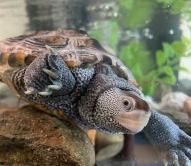
Space is limited, register early at audubonstars.eventbrite.com.


From ceremonies in seasonal gardens to receptions in a historic barn or award-winning aquarium and natural history museum, Audubon has two locations available for unforgettable weddings.
The Audubon Nature Center and Aquarium in Bristol, RI and The Barn at Caratunk in Seekonk, MA offer an extraordinary nature-inspired destinations for wedding receptions, ceremonies, and bridal showers.

Audubon Nature Center and Aquarium, Bristol, RI
• Indoor capacity of up to 125 guests
• Set on 28 acres with gardens, meadows, and a boardwalk trail to views of Narragansett Bay

Barn at Caratunk Wildlife Refuge Seekonk, MA
• Indoor capacity of up to 100 guests
• Surrounded by nearly 200 acres of serene forest and trails


• All areas are available for photography and guest enjoyment through dusk.
• Both locations provide climate-controlled indoor spaces, outdoor patios, gardens, and accessible restrooms.
• Experienced Audubon staff on duty throughout the event.

• Audubon can connect you to trusted rental companies and vendors.
• Private rooms available for bridal party.
• Reception fees vary by day of the week and time of the year, beginning at $1,500.
• Ceremony Only services start at $400.
To discuss additional details or reserve your date, contact Sarah Bradley at 401-949-5454 x3016 or sbradley@asri.org.

The eight eyes on these spiders enable them to see almost 360°. Actual spider size is 0.5–0.75 in.
They live all around us, but they are usually quite small and very quiet. You might not realize they are close by busily catching insects in the garden, under the porch, or down in the basement.
Spiders belong to a group of invertebrates called Arachnids that also includes scorpions, ticks, mites and harvestmen (daddy longlegs).
They have two body parts – a cephalothorax and an abdomen that are joined together by a narrow pedicel.
Spiders have eight legs that are attached to the cephalothorax and two other intriguing appendages called pedipalps. Depending upon the type of spider, the pedipalps can be used for feeding, walking, sensing, communication or reproduction.
Although their fangs are used to inject venom into their prey, most spiders are much too small to bite humans and most venom is not potent enough to cause harm.

Jumping spiders do just that –they jump on their prey!


By Lauren Parmelee, Senior Director of
legs
legs


spinneret
pedipalps

pedicel cephalothorax
abdomen
Silk is a wonderous substance produced by organs called spinnerets, located under the spider’s abdomen. These amazing creatures use silk for webs, to travel through the air, to court a mate, build egg cases, and wrap prey. While it seems easy to dust the cobwebs off a ceiling, physics tell us that when you compare strength to weight, spider silk is stronger than steel.


use silk to carry their eggs around.

Orb
produce beautiful spiral-shaped webs.
Over the past year, Audubon experts and other local scientists have led popular in-depth natural history classes through the Field Naturalist Series, covering tracking, birding, insects, ecosystems, fungi, plants and more. Indoor lectures and outdoor investigations on Audubon wildlife refuges culminate in a solid base of knowledge for beginner naturalists. This winter, a series of wildlife tracking classes begins on January 10.
Come join the fun, meet new friends, and indulge your curiosity in the natural world. Visit asri.org/calendar to register for the tracking session and watch for a new series of classes coming this spring.

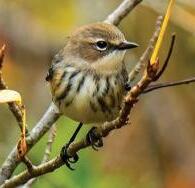

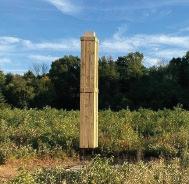

The many bridges and boardwalks that needed repair at the Fisherville Brook Wildlife Refuge in Exeter have been upgraded or replaced this summer, an accomplishment that the properties staff can be proud of. Thanks to staff and volunteers, visitors will experience drier, more comfortable hikes this fall.
Audubon has removed a large section of invasive species at the Haffenreffer Wildlife Refuge in Little Compton, including autumn olive, multiflora rose, and privet. In late fall, native grasses and plants will be added to the landscape. The coastal grassland and shrubby edges on this property provide key stopover spots for migrating birds and pollinators such as monarch butterflies.
Peter Green
Do you hear mowing on the wildlife refuge? This is a common fall event for most properties with fields. Keeping the woody growth down is a priority to preserve critical field habitat for the many species that depend on it for survival.
Several Chimney Swifts were spotted checking out the nesting towers that Audubon has built in Seekonk, Providence, and Exeter to support this species in decline. Although there was no confirmed report of the birds entering the structures, they will be monitored again in 2026 with hopes for a successful season.
Audubon is participating in Snapshot
USA, a large-scale collaborative survey of mammals in the US states and territories. Trends and correlations are emerging, such as influences of habitat features and disturbances on wildlife. Photo sampling for this project, using eight trail cams, began in August at Fisherville Brook Wildlife Refuge over a two-mile forest transect.
Thanks to a loan of the cameras from Narragansett Bay National Estuarine Research Reserve on Prudence Island, this location was monitored through September and October. All images will be reviewed, species tallied, and data shared with the national project manager.
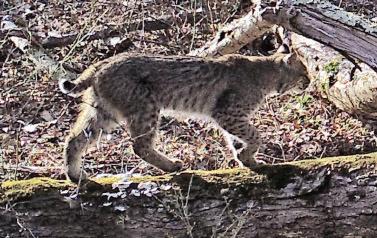





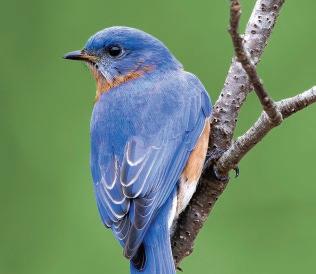


New Land Under Audubon’s Care Will Further Protect
By Dr. Scott Ruhren, Senior Director of Conservation
Adjacent to the Audubon Maxwell Mays Wildlife Refuge in Coventry sits a 55-acre parcel of untouched forested habitat in a rapidly changing landscape. This property contains vital streams, vernal pools and swamps which provide homes for yearround wildlife species as well as migratory birds like Scarlet Tanagers, Wood Thrush, Eastern Wood-pewee, Pileated Woodpecker, and Ovenbird.

When Anni and Vahe Bedian recently bought this land, they wished to protect the natural habitats found within it. Knowing that Audubon owned and carefully managed the neighboring Maxwell Mays Wildlife Refuge, they began conversations with Senior Director of Conservation Scott Ruhren to develop the best plan to keep their land in a natural state.
After a year of careful planning and discussion, the Bedians recently donated a conservation easement to Audubon. In this voluntary legal agreement, the family will continue to own the land, Audubon will monitor the property, and restrictions on development will keep the land permanently protected. All per the Bedian’s wishes.
“We have always loved and appreciated open spaces and supported conservation efforts. We feel we humans have taken way too much space for ourselves in the name of “development”, forgetting that we need the trees, flowers, birds and wildlife to keep a healthy balance in the world. That is why we are delighted to partner with the Audubon Society to protect this parcel of land for habitat conservation,” shared Anni and Vahe Bedian.
“This new conservation easement is critically important because it both protects a new swath of natural habitat and also strengthens the protection of the 295-acre Maxwell Mays Wildlife Refuge,” explained Audubon Senior Director of Conservation Scott Ruhren. “When I’ve explored the Bedian’s land, witnessing the rolling rocky terrain with mixed forest species and abundant wildlife, it is clearly a rich and strategically situated property.”
Increasing the size of current wildlife refuges is a universal goal in land protection. Audubon often works with landowners to add valuable acreage to our properties, and through the process becomes a trusted partner for families who are looking for conservation plans. “An exciting aspect of our work is being able to collaborate with individuals and families on their goals and wishes for land conservation,” said Audubon Executive Director Jeff Hall. “We are grateful
We have always loved and appreciated open spaces and supported conservation efforts. We feel we humans have taken way too much space for ourselves in the name of “development”, forgetting that we need the trees, flowers, birds and wildlife to keep a healthy balance in the world.”
“ “
– Anni and Vahe Bedian


to the Bedian family for helping Audubon expand protection of the Maxwell Mays Wildlife Refuge and the natural biodiversity found in Rhode Island.”
For over 125 years Audubon has been a trusted partner to landowners, tailoring permanent conservation plans for families. Contact Scott Ruhren, Senior Director of Conservation, to discuss ways you can work with Audubon. Email sruhren@asri.org or call 401-9495454 ext 3004.
Grab your wooly mittens and bundle up this winter to watch the meteors with s’mores, search for waterfowl on the Bay, look for ice needles and frost flowers on the refuge, or warm up and visit some cool marine creatures in the aquarium.



Bundle up, grab your binoculars, and search for resident bird species and seasonal visitors this winter in Bristol. Offered every other Friday. Visit asri.org/calendar for details.
The observation platform at the end of the boardwalk offers a prime viewing location for a wide variety of ducks and waterfowl during the winter months!


Member Event! The skies will come alive as the Geminid Meteor shower peaks on December 13, 2025. Enjoy firepits, s’mores, and watch the meteors! Visit audubonstars.eventbrite.com.
Bring the brood on December 27, 2025, and learn about the unique strategies and adaptations used by local wildlife species to help them survive the cold. Examine real animal biofacts! Ages: 5+. Register at asri.org/calendar
When you need a break from the cold, warm up with a visit to the Little Skates and other amazing marine life in the aquarium exhibits.
Audubon offers hands-on homeschool adventures for ages 6 to 10. This 8-week session blends science, art, and outdoor exploration through interactive lessons, hikes, games, and more. Students investigate local habitats, discover how animals and plants adapt in nature, and take part in real-world science. Classes begin February 12, 2026. Visit asri.org/calendar for more information.
Take a frosty hike and wander down to the wetlands to view ice needles, frost flowers, and more after the cold sets in. And get creative on December 20, 2025, with an evening of winter-themed watercolor painting. Open to all levels. Ages: 14+.
Visit asri.org/calendar to register.
Add some excitement to December and February school vacation weeks! Fun activities for the whole family include animal encounters, story times, nature hikes, and special programs. All included with admission. Visit asri.org/calendar.

Nature’s Highway: Flyway of Life Film Screening
Join explorer Tomas Koeck on December 6, 2025, for a film screening and conversation as he examines several unlikely relationships along the essential migratory route of the Atlantic Flyway chain. See page 21 for details.
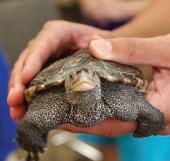

Kids learn about animal adaptations and survival, how natural selection works, and meet a live turtle named Darwin!
February 14, 2026; Ages: 5+.
Learn more at asri.org/calendar.

The Nature Center and Aquarium is now a participant in the Museums for All, joining over 1,500 museums across the country offering reduced ($3 per person) admission to those receiving food assistance (SNAP benefits).
Come discover the incredible species of owls that call Rhode Island home. Audubon offers opportunities this winter for all ages to learn about these amazing birds. Owl programs fill quickly. Visit asri.org/calendar for details and to register.
• Family Owl Prowls: December 4, 2025 and January 3, 2026. Ages: All.
• Owls and Ales: January 9, 2026. Ages: 21+
• Hoots and Hot Chocolate: February 7, 2026. Ages: 5+.



• Reaching more communities to expand environmental literacy.
• Acquiring land for vital bird and wildlife conservation.
• Building on the Avian Research Initiative to support bird species in decline.
• Promoting science-based advocacy to protect wildlife and support climate resiliency.
• Repowering Audubon with renewable energy resources to power our

October 19, 2025
The 128th Annual Meeting highlighted statewide efforts to expand access to nature and connect with communities. Executive Director Jeff Hall emphasized the inclusive, transformative work Audubon is doing to deepen the human-nature connection. Keynote speaker David Gregg shared insights on ecological relationships and eco-systemwide conservation strategies needed to protect biodiversity.
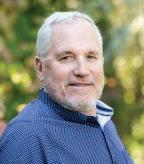
Allott has worked in land conservation and conservation law for over three decades in Rhode Island. A former Executive Director of the Aquidneck Island Land Trust, he currently serves on the Board of Directors of the Agriculture Land Preservation Commission.
Booher is a Principal and Partner at DBVW Architects in Providence. He serves as a Commissioner of the Rhode Island Historical Preservation & Heritage Commission and is a Trustee of the Providence Preservation Society.


Left to right: Audubon Executive Director Jeffrey Hall with Keynote Speaker and RI Natural History Survey Executive Director David Gregg.

Longval is currently Legal Counsel for the Rhode Island Department of Business Regulation. She also serves on the Coast Access Improvement Committee in the Town of Narragansett, advising the Town Council on matters concerning shoreline access.
The Audubon Society of Rhode Island gratefully acknowledges the terms of service of board members Don Heitzmann, Laura Landen, and John Woulfe, who are stepping down from the board of directors this year.
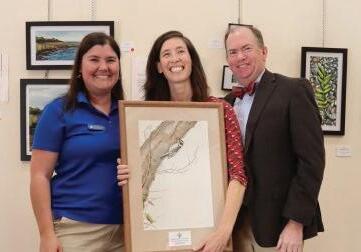
Sophia Academy
Wood was honored for her dedication to environmental education and an ongoing collaboration with the Stormwater Innovation Center to bring water quality programming to students in the classroom, through field trips, and STEAM-based projects.
Left to right: Audubon Associate Director of Education April Alix, Alyssa Wood, Audubon Executive Director Jeffrey Hall.
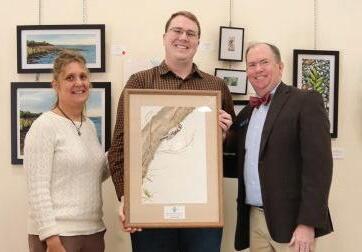
Osprey Nest Monitoring Program
Dark was recognized for his service managing the Osprey Nest Monitoring Program, tirelessly working with a team of volunteers to collect data on the health of these raptors.
Left to right: Audubon Director of Properties Laura Carberry, Lincoln Dark, Audubon Executive Director Jeffrey Hall.

Audubon recognized Senator Bissaillon and Representative Carol McEntee for their dedication to Rhode Island’s environment and protection of birds and wildlife.
Left to right: Audubon Board President Dave Caldwell, Senator Jacob Bissaillon, Representative Carol McEntee, Audubon Executive Director Jeffrey Hall.
The companies listed below have demonstrated their significant commitment to the quality of life in Rhode Island and to conserving natural habitats through stewardship and education.
Bank of America, Caldwell Realty Rhode Island, The Fogarty Center, Green Century Capital Management, St. Gobain, JDRE Homes, NEC Solar, NOW 93.3, NRCS, Prickly Ed's Cactus Patch Native Plant Emporium
The people listed below have been honored by family and friends who found a gift to the Audubon Society of Rhode Island to be the most meaningful way to celebrate someone important in their lives.
In Honor of:
Connie Bidwell Brines from Molly Bidwell and family
Costanza Birding Tours from Allen Schenck
Maurice Boulais from Paul Stadnick
Frank Golet from Art and Marion Gold
Stone and Tallulah from Samantha Dugan
April Vaillancourt and Aaron Weisensee from Catherine Sullivan
Memorials serve and support the conservation and protection of Rhode Island’s environment. The families and friends of people listed below have chosen to remember their loved ones through a gift to the Audubon Society of Rhode Island.
Dave Caldwell, Sr. from Emily Wescott
Judy DiPolito from Anonymous
Darrell Dumont from Jennifer Pedro
Arlene Hartwell from Robert and Camille Hamel, Nike Kendall Ed Hughes from Sophia Demaio, Peter Fish, William Hughes, Tom Kelly, Barbara Rossi
Mary Ann Jolicoeur from Joanne Billington
Richard Leach from Maria Barry, Mike Carter, David Covitz, Robert Feltz, Joan Gille, Jeanne Keith, Thyra Laemmel, Linda Lennon, Karen Richards, Thomas Sarubbi, Elizabeth Sherman
Peter Lisle from Ann Baker, Samuel Hallowell, Jr., David Izzi, Peter Lacouture, John and Denise Marginson, Martha Milot, Richard and Trudy Sharpe, Jane and Dick Tedder, Emily Westcott
Peter Parsons Frazier from Elizabeth Gallagher and Lyft, Cynthia and Joe Kane, William Scannell
Douglas Phillips Whitmarsh from Cushing Anderson, David Rozendale, Cynthia Spencer
Beverly Pyne from Chris and Lisa Kaneb
Dominick Zoccoli from Robert Rice





Roy A. Hunt Foundation Awards Audubon $5,000 to Support Environmental Conservation
Thank you to the Roy A. Hunt Foundation for supporting Audubon’s mission to protect Rhode Island’s natural resources. These funds will be used to manage and protect close to 10,000 acres of pristine natural habitat across the state.
Audubon Receives Generous Funding to Support Volunteer Program
An anonymous funder has generously provided a $150,000 grant to expand Audubon’s vital volunteer program by funding a new Volunteer Coordinator position. This new staff member will oversee Audubon's robust volunteer program, ensuring volunteers are trained, supported, and fulfilled by their service to Audubon.
Thanks to Bank of America, Audubon offered free admission to the Nature Center and Aquarium in Bristol on three Saturdays this fall. With their generous funding of $2,500, families and individuals enjoyed animal discoveries, crafts, hikes, and more - all free of charge – making nature more accessible to all.
Audubon thanks an anonymous funder for a $10,000 grant to expand access to nature and environmental education in Rhode Island's core cities. This support allows Audubon educators to continue engagement and programming with city communities, and to partner with urban organizations on environmental initiatives.
Agenerous family in Jamestown has donated $10,000 to Audubon for vital habitat restoration at the Racquet Road Wildlife Refuge in Jamestown. This funding will be used for invasive plant control and habitat restoration to support bird and pollinator populations.
Do you have an Audubon education program, research initiative, or conservation project that has special meaning to you? Our wish list is full of needed items, both big and small, that would support our work.
To choose one item, or support an entire initiative, visit asri.org/wishlist. Thank you for your support!

Over $1,327,000 has been raised to date by generous donors to support Audubon’s transition to a clean energy future. Audubon is grateful for the gifts from members, supporters, corporations, and grants that are helping us to reach our long term sustainability goals.
Recent donations include:
Anonymous Donor: $25,000
Anonymous Donor: $200,000
Caldwell and Johnson, Inc.: $10,000
Generous Family from Massachusetts: $35,000
Winter Waterfowl Van Trip
January 10, 2026
Explore Rhode Island’s coastal habitats and ponds in search of winter waterfowl and seabirds. Ages: 16+.
Winter Birds on Cape Cod
January 17, 2026
Enjoy an overnight on Cape Cod to explore and look for wintering waterfowl and other birds.
Ages: Adult.

Winter Van Trip to Cape Ann February 28, 2026
This historic fishing community is known for a great diversity of wintering sea birds. Ages: Teen to Adult.


The Audubon Endowment is a permanently restricted fund that, by law, exists in perpetuity. Because the Audubon Endowment is invested, it allows for long-term stability, fiscal responsibility, and financial viability that keeps Audubon a vibrant and growing organization.
It also enhances our credibility, relieves pressure on fund raising, allows program expansion, and provides independence.
Donations of $10,000 or more to the Audubon Endowment can be recognized by a named designation, either for an individual, family, or a cause you believe in.
Audubon Society of Rhode Island Named Endowments
Aust-Capron Memorial Fund
Barter-Moore Fund
Edith Becker Fund
Mary Catherine Rogers Beckett Fund
John Brezinski Memorial Fund
Bristol Education Center Fund
Caratunk Fund
Mary B. Cottrell Fund
Severyn Dana Fund
Davis Memorial Wildlife Fund
Norman A. Deslauriers Fund
Dickens Farm Fund
Patricia Meagher Dwyer Conservation Fund
John Raleigh Eldred Fund
Bayard Ewing Fund
Fisherville Brook Fund
Fort Nature Refuge Fund
Grout Memorial Fund
Alice O. Harris Fund
Jonathan H. Harwood Fund
Hicks-Borden Fund
Priscilla J. Hollis Fund
Mary C. Kellermann Endowment Fund
Walter Hammond Kimball Fund
Crawford N. Kirkpatrick III Fund
Margaret Robinson Knight Fund
Kimball Memorial Garden Stewardship Fund
Kay Kinsey Fund
Kraus Wildlife Fund
Henry J. Larkin Wildlife Preserve Fund
Lorraine Leaney Fund
Little Rest Bird Club Fund
Lonesome Swamp Fund
Edward B. and Phoebe W. McAlpine Memorial Preserve Fund
Constance McCarthy Fund
McKenzie Wildlife Fund
George B. Parker Fund
Powder Mill Ledges Fund
Prudence Island Fund
Susan M. Romano Memorial Fund
Elton Sanford Fund
Alicia Perry Seavey Family Fund
South County Fund
Everett F. Southwick Fund
Touisset Marsh Fund
Viall Memorial Library Fund
Mrs. and Mr. Dudley A. Williams Memorial Fund
For more information contact Jeff Hall at jhall@asri.org or (401)-949-5454 ext. 3017.
Home to 100 acres of field, deep woodlands, and interesting rock outcroppings, Powder Mill Ledges Wildlife Refuge is ideal for hiking, bird watching, and snowshoeing in winter.



The 2026 Audubon Field Naturalist Series kicks off on January 10 with three sessions on tracking. Sign up early and head out to look for signs of wildlife on the winter trails! Visit asri.org/calendar.
Audubon offers birthday parties for children at Powder Mill Ledges. Parties include guided outdoor explorations and indoor festivities. Invite an owl, turtle, or snake to join the fun! Plan a celebration at asri.org/birthday-parties



Search for owls during this quiet and magical time of year on the trails. Powder Mill Ledges offers many owl prowls and programs this winter. Register early as they fill quickly. Visit asri.org/calendar.
Stay awhile longer! Audubon’s Headquarters is located at Powder Mill Ledges and offers indoor restroom facilities on weekdays from 9:30am–4:30 pm.



After a fresh snowfall, enjoy a snowshoe trek on the trails. Bundle up and experience the beauty of nature in winter.
Audubon headquarters recently replaced an old HVAC system with heat pumps that run on electricity; a step in the RePower
Audubon initiative for a clean energy future. A carport with solar panels at this location will eventually play a large role in allowing all facilities to transition to renewable energy. Learn more at asri.org/repower.
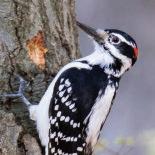


While wildlife refuges can be quiet in winter, Powder Mill Ledges is home to Pileated, Downy, Hairy, and Red-bellied Woodpeckers. With bare branches allowing good views, this is a great time to go birding and spot these and other species.
Audubon offers birdseed sales throughout the winter, with Powder Mill Ledges as a convenient pick-up location. Watch for details on our website or social media. The next sale runs January 1-15, 2026, with pick-up scheduled for February 7.
Engaging City Communities with Water Ecology, Stories, and Art

The Stormwater Innovation Center (SIC) will be uplifting conservation and green infrastructure efforts through storytelling at Roger Williams Park. For those familiar with StoryWalks, which typically consist of pages from children’s books posted along a path, this concept is similar, except, “the story we’re telling is that of the ecology, history, and water quality management in Roger Williams Park,” explains StoryWalk Project Manager Jessy Minker.
Posted along a 3.7-mile loop trail that weaves along ponds in the park, SIC’s creative endeavor will feature signage, games, and community-contributed elements that help visitors make connections between how their actions – such as reducing fertilizer use and installing rain barrels – affect the health of the ecosystem. Minker explains that the aim is to “give people the information and tools to be stewards of their watershed.”
At the Rain Harvest Festival on September 28, a workshop disseminated the goals of the project to curious visitors and invited them to share memories and art inspired by Roger Williams Park. Once fully realized, the immersive StoryWalk will not only feature signage, but also QR codes to enable deeper engagement with water quality concepts, as well as an interactive map with geo-referenced stories, turning the whole park into a network of connection and education.
The StoryWalk team is looking forward to a Summer 2026 installation, and all are welcome to submit images, video, audio, or text stories and art to tinyurl.com/RWPstorywalk by November 30, 2025.
Another fruitful collaboration Audubon has forged is with Providence Promise, a parent-driven partnership that propels Providence Public School and Charter School students on paths to post-secondary education. Over the years, Audubon Community Education Coordinator Lisa Maloney has worked with the organization and parents to find out what kind of programming is most valued; often that has been bringing students to the Audubon Nature Center and Aquarium in Bristol or Caratunk Wildlife Refuge in Seekonk for programs. The biggest barrier is often transportation, and Maloney has worked with the Providence Promise families to find creative solutions through Audubon donor-supported scholarships to make these field trips happen.
In August, Maloney also tabled at the Providence Promise Career Summit. With biofacts like pelts and skulls spread out before her, she opened conversations with a challenge for students to guess what kind of animal each piece belonged to – a fun segue into talking about the work she does every day and potential environmental careers.
Welcoming All to the Birding Community
These city birding events resumed in September with a bird banding and guided program at Roger Williams Park. In collaboration with the Providence Urban Wildlife Conservation Partnership, Audubon hosts these monthly outings, prioritizing sites that participants can bike or take a bus to, and which feature accessible trails.
Abbie Lahmers is a communications specialist for both the Metcalf Institute at the University of Rhode Island and Roger Williams Park Conservancy, as well as a freelancewriterwhoenjoyshiking,camping,andbirdingaroundNewEngland.Shecanbe reached at amlahmers@gmail.com.
Anewer affiliation of AmeriCorps, TerraCorps was founded on the principles and practices of service with an emphasis on land conservation.
Abby Paull

Abby Paull will take on the role of Audubon Land Stewardship Coordinator as a second-year TerraCorps Service Member. After graduating from Vassar College with a degree in biology, she served last year at Coggeshall Farm Museum. Abby will develop three capacity building projects involving community science, community programing, and working in conservation.
Malia Cafasso

New TerraCorps Community Outreach Coordinator Malia Cafasso will work with the Stormwater Innovation Center, expanding and sustaining community engagement and science programs. She will primarily focus on community science monitoring initiatives and outreach, and supporting the Stormwater in Schools program, which brings water quality lessons into Rhode Island classrooms each year.

As the new TerraCorps Community Engagement Coordinator, Josephine Doucette will work in schools, community centers, and with other partners to deepen Audubon’s impact in Rhode Island’s core cities. She recently graduated from Barnard College with a degree in neuroscience, and is passionate about using art and community participation to bridge the gap between people and science.
By Katie Schortmann, Pollinator Outreach Coordinator and Master Gardener EDITORIAL
Plant communities provide a natural system that ensures that members get what they need.
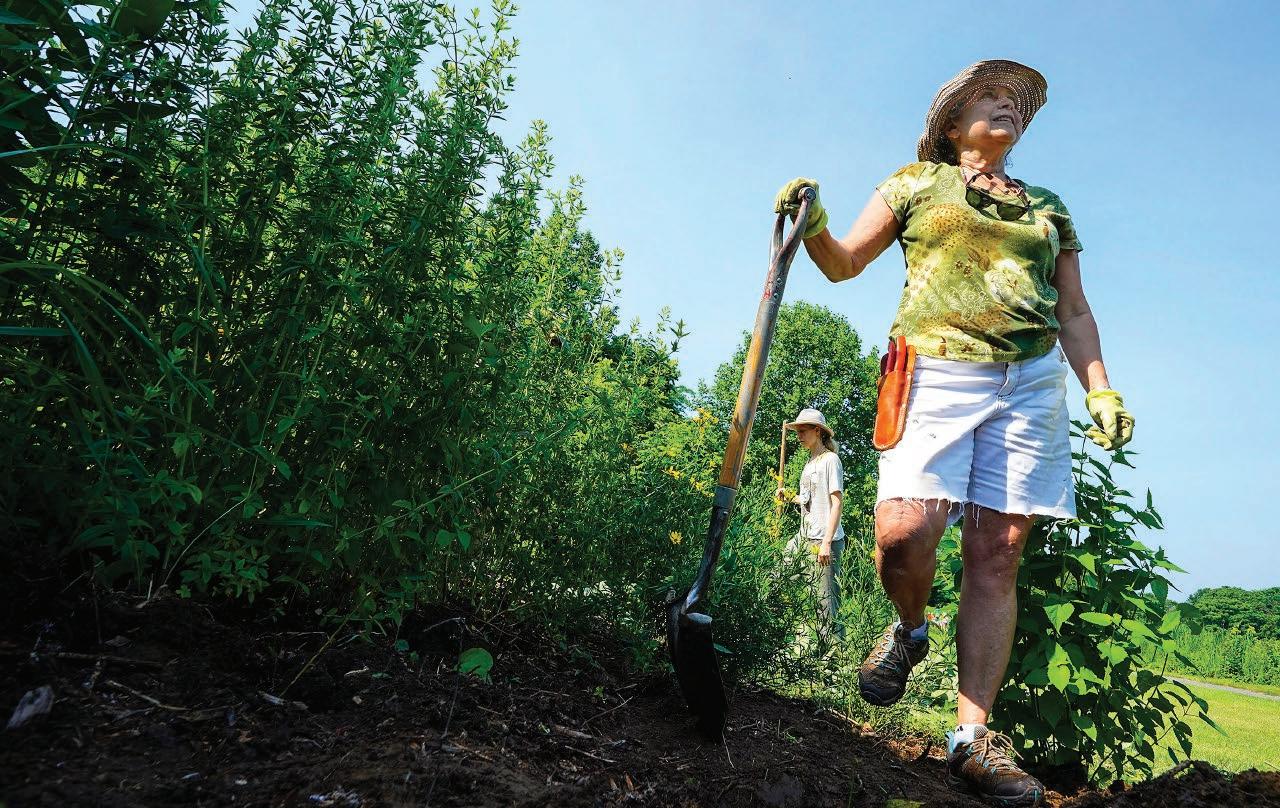
If you are lucky enough to call yourself a gardener, then you know humility. The best laid plans made in the depths of winter are often forgotten to the reality of limitations. Temporal, financial, and physical ability to carry out those plans is often altered. Like a sapling in the woods by a recently fallen oak –we must be willing to grow in different directions when life doesn’t go as planned.
Good gardeners are always learning and seeking to work with nature to create beauty, habitat, and a controlled abundance. The Palmieri Pollinator Garden is constantly in succession; seeking to become the Northeastern Forest of its dreams. It is the gardener’s duty to keep it in check and make the many decisions of what stays and what goes. Those choices are made easier when you know the players and the ways they tend to behave next to each other.
Plant communities provide a natural system that ensures that members get what they need. Baptisia tap roots wriggle through the matted roots of mountain mints to find water otherwise unavailable. Spring ephemerals like Virginia Bluebells race to complete their entire lives in March and April so they may drop their seeds before the mighty maple shakes out it’s fresh greenery, casting shade on the soil and limiting that sunshine.
Plant communities thrive when niches are filled and not constantly competing. Nature is intricate in its evolved cooperation. It is an important reminder to the humans in the garden. The desire for community must rest in allowing space for others to grow and shine when it is their season. To share the abundance of the summer rains when it arrives and shade those that cannot withstand the scorching sun.
Our human garden community is also everchanging and enriching
this parcel of habitat. Friendships, new careers, and hobbies are seeded and watered by conversations over the milkweed. School gardens have been nourished with information, seeds, and plants shared under the apple trees. We are better together and the reach of our connections is our legacy. Rippling beyond our vision.

The success of the Palmieri Pollinator Garden project cannot be measured in a list of species, in the number of volunteer hours, or the cost analysis of this space. It is successful because of its inherent existence. The culmination of efforts by many determined people - doctors, professors, community service members, master and novice gardeners. And teenagers that aren’t sure how to dig a hole. All of them creating memories in the garden. Niches filled by smiling faces; a reminder that change is actionable and hope springs eternal.
Audubon Society of Rhode Island
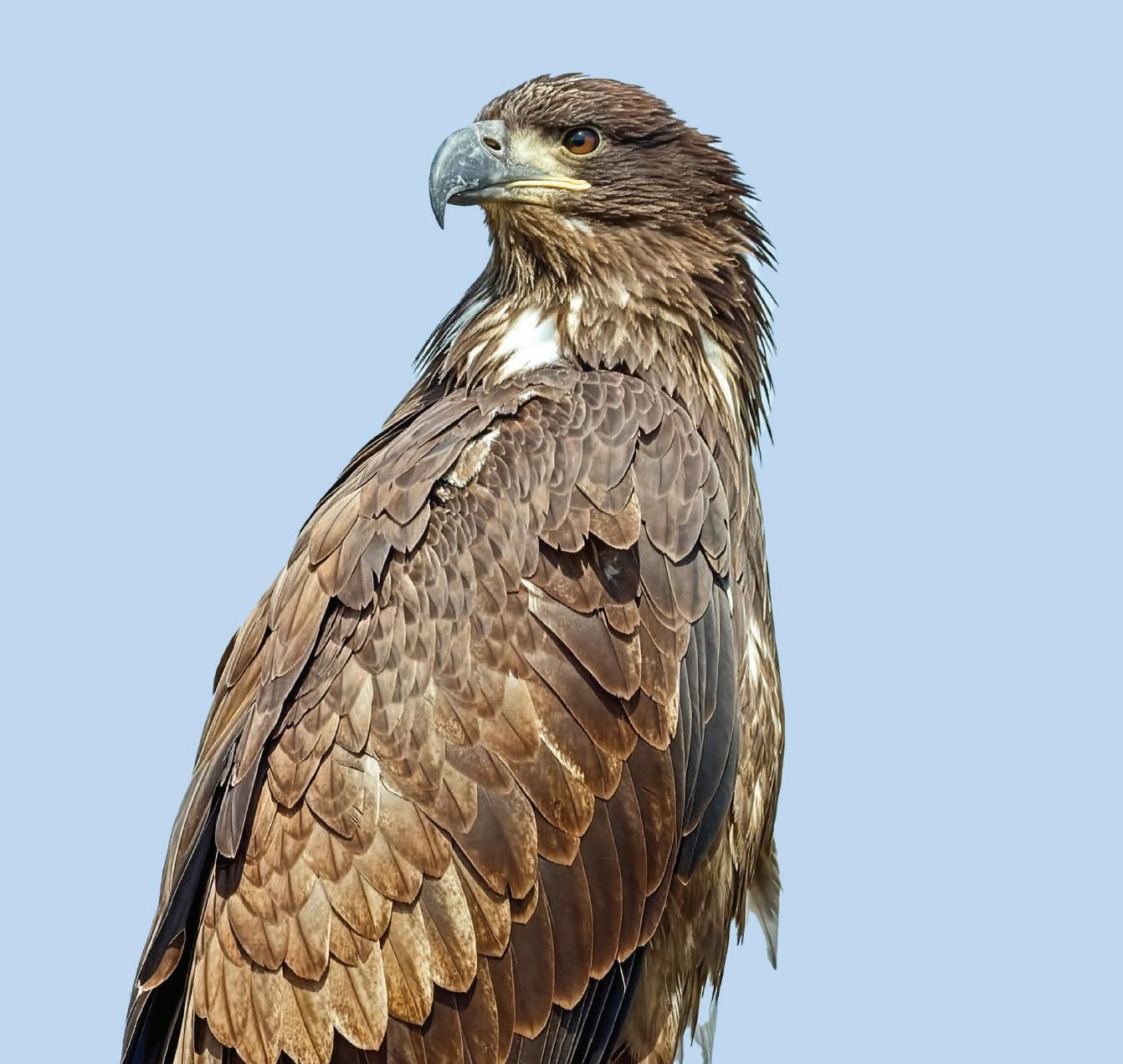
two-year-old juvenile Bald Eagle will call Audubon home in 2026. This beautiful female raptor sustained severe injuries as a fledgling when a tornado destroyed her nest in Indiana. Despite expert care with plenty of time to heal, she remains unable to fly.
Weighing in at 15 pounds, she will require an expansive mew, equipment for her caregivers, veterinary care, cost of transportation, and plenty of meat and fish for her diet. Please help us welcome this Bald Eagle by donating today!
Visit asri.org/eagle-fund. Will You Help Audubon Welcome Her Home?